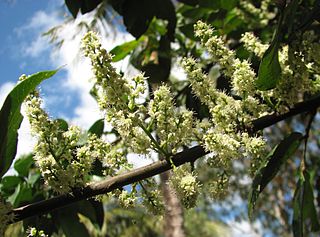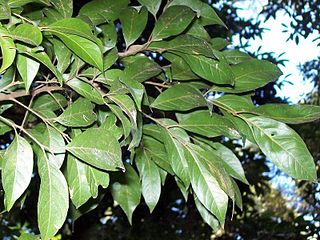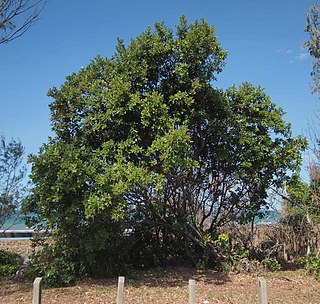
Alectryon is a genus of about 30 species of trees and shrubs from the family Sapindaceae. They grow naturally across Australasia, Papuasia, Melanesia, western Polynesia, east Malesia and Southeast Asia, including across mainland Australia, especially diverse in eastern Queensland and New South Wales, the Torres Strait Islands, New Guinea, the Solomon Islands, New Caledonia, New Zealand, Vanuatu, Fiji, Samoa, Hawaii, Indonesia and the Philippines. They grow in a wide variety of natural habitats, from rainforests, gallery forests and coastal forests to arid savannas and heaths.

Sapindus is a genus of about five to twelve species of shrubs and small trees in the lychee family, Sapindaceae, native to warm temperate to tropical regions of the world. The genus includes both deciduous and evergreen species. Members of the genus are commonly known as soapberries or soapnuts because the fruit pulp is used to make soap. The generic name is derived from the Latin words sapo, meaning "soap", and indicus, meaning "of India".

Cupaniopsis is a genus of about 67 species of trees and shrubs of the soapberry family, Sapindaceae. They grow naturally in New Guinea, New Caledonia, Australia, Torres Strait Islands, Fiji, Samoa, Sulawesi, Micronesia. Many species have been threatened with extinction globally or nationally, with official recognition by the International Union for Conservation of Nature (IUCN) and several national and state governments.

Harpullia is a genus of about 27 species of small to medium-sized rainforest trees from the family Sapindaceae. They have a wide distribution ranging from India eastwards through Malesia, Papuasia and Australasia to the Pacific Islands. They grow naturally usually in or on the margins of rainforests or associated vegetation.

Jagera is a genus of 4 species of forest trees known to science, constituting part of the plant family Sapindaceae.

Guioa is a genus of about 78 rainforest tree species known to science, which constitute part of the plant family Sapindaceae. They have a wide distribution, ranging from throughout Malesia, in Burma, Cambodia, Vietnam, Thailand, Malay Peninsula, Borneo, Sumatra, Philippines, Java, Flores, Timor, Sulawesi, Moluccas, New Guinea, further southwards through the east coast of Queensland and New South Wales, Australia and further eastwards to the Pacific Islands, including Tonga, New Caledonia, Fiji and Samoa.

Arytera is a genus of about twenty–eight species known to science, of trees and shrubs and constituting part of the plant family Sapindaceae. They grow naturally in New Guinea, Indonesia, New Caledonia, Australia, the Solomon Islands, Vanuatu, Fiji, Samoa, Tonga; and the most widespread species and type species A. littoralis grows throughout Malesia and across Southeast Asia, from NE. India, southern China, Borneo, Malaysia, Singapore, Indonesia and the Philippines to as far east as New Guinea and the Solomon Islands.

Elattostachys is a genus of about 21 species of trees known to science, constituting part of the plant family Sapindaceae.

Lepisanthes is a genus of 24 or 25 species of trees or shrubs native to tropical Africa, south and southeast Asia, Australia, and Madagascar.

Dodonaeoideae is a subfamily of flowering plants in the soapberry family, Sapindaceae.

Sarcopteryx is a genus of about 12 rainforest tree species known to science, of the plant family Sapindaceae. They occur in Australia, New Guinea and the Moluccas.
Tristiropsis is a genus of about 14 flowering trees species, of the plant family Sapindaceae.

Mischarytera is a genus of rainforest trees, constituting part of the plant family Sapindaceae. Four species are known to science as of December 2013, found growing naturally in eastern Queensland, Australia, and in New Guinea. Formerly until 1995, they had names within the genus Arytera, subgenus Mischarytera.
Rhysotoechia is a genus of tropical rainforest trees, constituting part of the plant family Sapindaceae.
Buchenavia capitata is a tree of the Caribbean and northeastern South-American regions. Its Spanish vernacular names include granadillo, almendro (Colombia), amarillo and olivo negro (Venezuela), and mirindiba and periquiteira (Brazil). Its English vernacular name is fourleaf buchenavia. It is also known as Buchenavia tetraphylla (Aubl.) Howard.

Alectryon connatus, sometimes named hairy alectryon, is a species of small trees, constituting part of the plant family Sapindaceae.
Lepisanthes senegalensis is a tree widespread through tropical Africa and tropical Asia to New Guinea and northern Australia.

Sapindoideae is a subfamily of flowering plants in the soapberry family, Sapindaceae.
Aporrhiza is a genus of flowering plants belonging to the family Sapindaceae.













